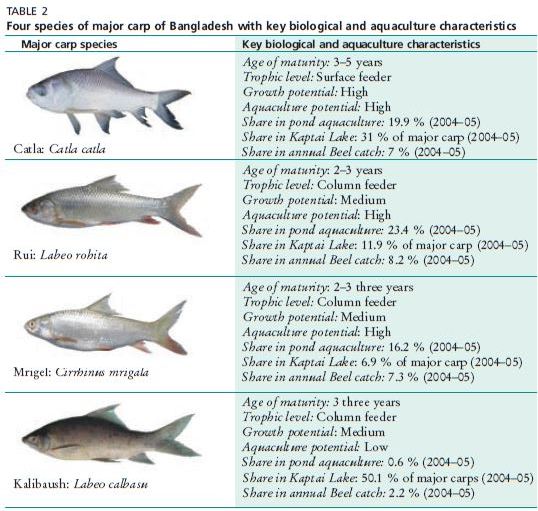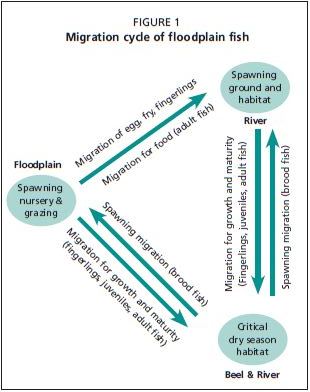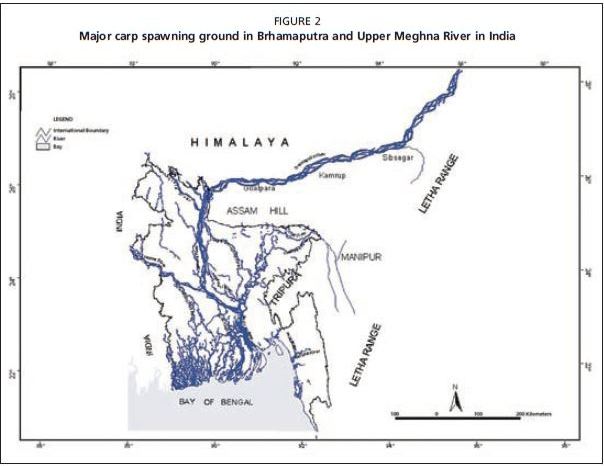MAJOR CARP FISHERY IN BANGLADESH
General information on the carp
The four species of carp found in the waters in Bangladesh are grouped together as Indian major carps: catla (Catla catla), roho labeo or rui (Labeo rohita), mrigel (Cirrhinus mrigala) and kalibaush (Labeo calbasu).
Although the age of maturity for spawning varies by species, all require at least two years to attain sexual maturity and spawning ability; rui require at least two years, mrigel requires 2–3 years, and catla and kalibaush mature at three years (Table 2).
TABLE 2
Four species of major carp of Bangladesh with key biological and aquaculture characteristics

All of these species require similar environmental conditions and use similar spawning grounds (Tsai and Ali, 1985). Each carp species undertakes a spawning migration to reach their respective breeding grounds (Tsai and Ali 1985, 1986).
The adult carp begin their spawning migration in the pre-monsoon season (March), coinciding with the gradual rise of water flow due to snow melt in the Himalayas, and the early rains and the rise in water temperatures. Spawning starts in May with the onset of southwest monsoon rains, and continues until July (Azadi, 1985; Shaha and Haque, 1976; Tsai and Ali, 1985). Soon after spawning, the adults and fish larvae migrate downstream to the floodplains for feeding and remain there for 4–5 months. They passively migrate with the water current, and drift laterally onto the extensive productive floodplains (Figure 1). They then migrate back to deeper areas in the rivers and beels for overwintering along with the receding water during late monsoon. The fish over-winter in these habitats, escaping mortality from fishing and natural causes, and start their spawning migration in the next pre-monsoon season. Although much is known about the spawning behaviour of major carp, there is little detailed knowledge of their spawning behaviour in relation to environmental requirements.
Wild stock of major carp
Based on the differences in the spawning grounds, spawning seasons, and geographic distribution, the major carp in Bangladesh are often divided into four stocks named by the respective river system: i) Brhamaputra-Jamuna stock, ii) Upper Padma stock, iii) Upper Meghna stock, and iv) Halda stock (Azadi, 1985; Tsai and Ali, 1985). There is little information available about another stock of major carp, in Kaptai Lake.
FIGURE 1
Migration cycle of floodplain fish

spawn within Bangladesh, as only major carp juveniles are collected from the Brhapamutra
Jamuan river systems even in the upper reaches of the river near the Indian border (Kurigram district). The Brhamaputra-Jamuna stock travels a long distance from the lower
reaches of the rivers to their spawning grounds at the southern tributaries of the upper Brahmaputra river in the Assam Hills and Letha Range, in Assam, India (Alikhuni, 1957) (Figure 2). The major carp in this stock spawn in the wild. Major pulses of spawn are caught in May and June, with less captured in July, coinciding with the onset of the southwest monsoon with the rise of water flow, temperatures and rainfall.
FIGURE 2
Major carp spawning ground in Brhamaputra and Upper Meghna River in India

Capture-based aquaculture of wild-caught Indian major carps in the Ganges Region of Bangladesh 131
The Brhamaputra stock of major carp start their spawning migration from their over-wintering habitats at the lower reaches in late February and continue until late April, coinciding with the gradual rise in water flow and temperature, and often with the start of the pre-monsoon rains. These fish perform a long, mostly longitudinal, migration to reach their spawning grounds. Soon after spawning the adults swim back along the river and laterally migrate to floodplains for feeding and growth until the late monsoon, and then they migrate to deeper pools in rivers in lower reaches as well as large perennial beels in the floodplains.
Upper Padma stock
This stock of major carp is found in the Padma River below the Farraka Dam and its associated tributaries, canals and beels. This stock occurs in the lower Meghna, Kumar, Arial Khan, and in other rivers below the confluence of the Padma and Jamuna rivers. This stock thus mixes with Brhamaputra-Jamuna stock due to close downstream connectivity among the rivers.
Similar to the Brahmaputra-Jamuan stock, no eggs from this stock are collected in the Padma River within Bangladesh, indicating that spawning occurs upstream and outside of Bangladesh. In neighboring India, the most important fry collection center in the Ganges River is upstream of Farraka Dam, where fry are collected from May to September (Jhingran, 1983). In Bangladesh, fry collection in the Padma River takes place during June, July and August, suggesting that there might be a different spawning ground of major carp in the Padma River downstream of the Farraka Dam (Tsai and Ali, 1985). Based on the time of availability of carp spawn in the Upper Padma, it is assumed that the spawning migration of major carp in the Padma River occurs from April to May/June, which is later than that of the Brhamaputra-Jamuna stock. As with the Brhamaputra-Jamuna stock, after spawning, the adults of the Padma stock move back and laterally migrate to flooded lands for feeding and growth.
Upper Meghna stock
This stock remains at the upper reaches of the Meghna River from its confluence with the Old Brhamaputra River, up to the tributaries, beels and haors in Bangladesh and India (Borak River basin). The major tributaries in the area include the Surma, Kushiyara and Khoai rivers that originate in the Letha Range, as well as the Boulai River that originates in the southern slope of the Assam Hills of India. There is relatively little information on carp spawning grounds and spawn collection centers on the upper Meghna in Bangladesh.
Unlike other river systems, there are no commercial carp spawn collection centers in the Upper Meghna River basin. Spawning of this stock may take place long distances upstream in India, or the spawning may be so limited that it does not attract fry/spawn collectors. However, some authors indicate that there are spawn collection centers located at the headwaters of the Surma River in Manipur province, and some in the Tripura province in India (Jhingran, 1983).
Paul (1997) does mention some locations where local fishermen collect carp spawn from the wild, noting seven carp spawn collection points in the greater Sylhet basin: i) Juri river in the Hakaluki haor upstream from the Fenchugonj Bridge; ii) Kawani River near Daulatpur and Milonpur, the Boroiya River near Shanbari bazaar, and the Baulai River near Mukshedpur in Dharampasha Upazila; iii) Baulai river near Alamduarer bank in Tahirpur upazila; iv) Surma River near Sunamgonj; v) Dhanu River near Ranichapur and Chalamati of Khaliajuri upazila; vi) Kalni River near Maruli of Derai Upazila; and vii) Khoiltajuri River near Dighirpar in Companigonj Upazila. However, these sites have not been investigated, and thus detailed information on the natural carp spawn collection and breeding grounds in the area is not available.
Halda stock
The Halda River in the southeast of Bangladesh originates from three major tributaries that come out of the Chittagong Hill tracts, namely the Dhurang, Talpari and Sareakhal. The river flows downstream and discharges into the Bay of Bengal, joining with the Karnafuli River at the south end where there are visible tidal effects. The river has meandering courses, and there are three ox-bends (Ankurdigji, Sonairchar and Urchirchar) in the southern reach of the river covering 32 km, that are reported to be the major carp spawning grounds. Three species of major carp (C. catla, L. rohita and C. mrigala) spawn in this tidal river every year. This is the only tidal river located very close to the coastline where major carp have been naturally spawning. This spawning ground is considered as one of the richest and oldest carp spawn fisheries, and has been meeting the demand of carp fry for pond aquaculture in the immediate area as well as much of the other parts of the country.
Other stock – Kaptai stock
This stock of major carp is limited to Kaptai Lake and its associated tributaries in the southeastern hill district of Bangladesh and constituted about 21 percent of the total landings (Hye, 1933). As with other stocks, spawning also occur here during May and June. Kaptai Lake, located in the Chittagong hill tract, is an oligotrophic lake containing a major carp stock, and the Freshwater Fisheries Research Sub
Station at Rangamati reports some carp spawning grounds in this lake. Collection of carp fry from the lake by the staff of the Research Sub-Station was noted by Azadi (1985). Possible spawning grounds in this lake included the Kassalong range (Mainimukh to Marishaya), the Barkal range (Subalong to border area), the Chengi range (Burighat to Mahalchari) and the Reinkonh range. These points are located at the headwaters of the Kaptai Lake however no detailed study on the major carp spawning is available.